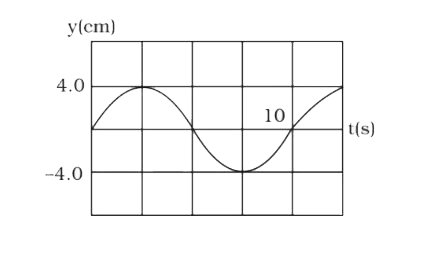A sinusoidal wave is traveling on a string with speed 40 cm/s. The displacement of the particle of the string at x = 10 cm varies with time according to
y = (5.0cm) sin(1.0−4.0s−1)t)The linear density of the string is 4.0 g/cm
the frequency of wave is 0.64 Hz
the wavelenght of the wave 63 cm
the tension in the string 0.064 N
the wave equation is y = (5.0cm) sin (0.1x−(4.0s−1t)
The correct Answer is:A, B, C, D
To solve the problem step by step, we will analyze the given information and apply the relevant physics concepts.
Given Data:
- Speed of the wave, V=40cm/s
- Displacement equation: y=(5.0cm)sin(1.0−4.0s−1⋅t)
- Linear density of the string, μ=4.0g/cm
Step 1: Identify Parameters from the Wave Equation
The general form of a sinusoidal wave is given by:
y=ymsin(kx−ωt)
From the given equation, we can identify:
- Amplitude, ym=5.0cm
- Angular frequency, ω=4.0s−1
Step 2: Calculate the Wavenumber k
The displacement equation can be rewritten as:
y=5.0sin(1.0−4.0t)
From this, we can see that kx=1.0 when t=0. Therefore, we can set k=1.0cm−1.
Step 3: Calculate the Frequency f
The frequency f can be calculated using the formula:
f=ω2π
Substituting the value of ω:
f=4.02π≈0.64Hz
Step 4: Calculate the Wavelength λ
The relationship between wavenumber k and wavelength λ is given by:
k=2πλ
Rearranging gives:
λ=2πk
Substituting k=1.0cm−1:
λ=2π1.0≈6.28cm≈63cm
Step 5: Calculate the Tension T in the String
Using the wave speed V and the linear density μ, we can find the tension T using the formula:
V=√Tμ
Rearranging gives:
T=μV2
First, convert μ from grams to kilograms:
μ=4.0g/cm=0.004kg/cm=0.004×100=0.4kg/m
Now substituting V=0.4m/s:
T=0.004kg/cm⋅(0.4m/s)2=0.004⋅0.16=0.00064N=0.064N
Step 6: Verify the Wave Equation
The wave equation can also be expressed as:
y=ymsin(kx−ωt)
Substituting ym=5.0cm, k=1.0cm−1, and ω=4.0s−1:
y=5.0sin(1.0x−4.0t)
Summary of Results:
1. Frequency f≈0.64Hz
2. Wavelength λ≈63cm
3. Tension T≈0.064N
4. Wave equation y=5.0sin(1.0x−4.0t)
- Speed of the wave, V=40cm/s
- Displacement equation: y=(5.0cm)sin(1.0−4.0s−1⋅t)
- Linear density of the string, μ=4.0g/cm
The general form of a sinusoidal wave is given by:
y=ymsin(kx−ωt)
From the given equation, we can identify:
- Amplitude, ym=5.0cm
- Angular frequency, ω=4.0s−1
The displacement equation can be rewritten as:
y=5.0sin(1.0−4.0t)
From this, we can see that kx=1.0 when t=0. Therefore, we can set k=1.0cm−1.
The frequency f can be calculated using the formula:
f=ω2π
Substituting the value of ω:
f=4.02π≈0.64Hz
The relationship between wavenumber k and wavelength λ is given by:
k=2πλ
Rearranging gives:
λ=2πk
Substituting k=1.0cm−1:
λ=2π1.0≈6.28cm≈63cm
Using the wave speed V and the linear density μ, we can find the tension T using the formula:
V=√Tμ
Rearranging gives:
T=μV2
First, convert μ from grams to kilograms:
μ=4.0g/cm=0.004kg/cm=0.004×100=0.4kg/m
Now substituting V=0.4m/s:
T=0.004kg/cm⋅(0.4m/s)2=0.004⋅0.16=0.00064N=0.064N
The wave equation can also be expressed as:
y=ymsin(kx−ωt)
Substituting ym=5.0cm, k=1.0cm−1, and ω=4.0s−1:
y=5.0sin(1.0x−4.0t)
1. Frequency f≈0.64Hz
2. Wavelength λ≈63cm
3. Tension T≈0.064N
4. Wave equation y=5.0sin(1.0x−4.0t)
Similar Questions
A wave pulse passing on a string with speed of 40cms−1 in the negative x direction has its maximum at x=0 at t=0. Where will this maximum be located at t=5s?
View SolutionFigure shows a wave pulse at t=0. The pulse moves to the right with a speed of 10cms^-1. Sketch the shape of the string at t=1s, 2s and 3s.

View SolutionA long string having a cross- sectional area 0.80mm2 and density 12.5gcm−3 is subjected to a tension of 64 N along the X-axis. One end of this string is attached to a vibrator moving in transverse direction at a frequency fo 20Hz. At t = 0. the source is at a maximujm displacement y= 1.0 cm. (a) Write the equation for the wave. (b) What is the displacement of the particle of the string at x = 50 cm at time t = 0.05 s ? (c) What is the velocity of this particle at this instant ?
View SolutionA wave travelling on a string at a speed of 10ms−1 causes each particle of the string to oscillate with a time period of 20 ms. (a) What is the wavelength of the wave ? (b) If the displacement of a particle is 1.5 mm at a certain instant, what will be the displacement of a particle 10 cm away from it at the same instant ?
View SolutionThe displacement of a particle executing SHM is given by
y=0.5 sin100t cm . The maximum speed of the particle is
View SolutionA transverse sine wave of amplitude 10 cm and wavelength 200 cm travels from left to right along a long horizontal stretched, string with a speed of 100 cm/s. Take the origin at left end of the string. At time t = 0 the left end of the string is at the origin and is moving downward. Then the equation of the wave will be ( in CGS system )
View SolutionThe equation for the vibration of a string fixed at both ends vibrating in its second harmonic is given by y=2sin(0.3cm−1)xcos((500πs−1)t)cm. The length of the string is :
View SolutionA transverse sinusoidal wave of wavelength 20 cm is moving along a string towards increasing x. the transverse displacement of the string particle at x=0 as a function of time is shown in figure.

Q. The velocity of propagation of the wave is ?
View SolutionThe equation of a wave on a string of linear mass density 0.04kgm−1 is given by
y=0.02(m)sin[2π(t0.04(s)−x0.50(m))].
Then tension in the string is
View SolutionThe equation of a travelling wave on a string is y = (0.10 mm )sin[31.4m−1x+(314s−1)t]
View Solution
